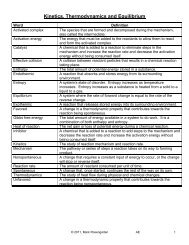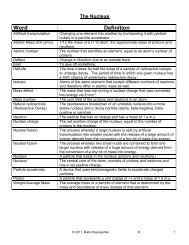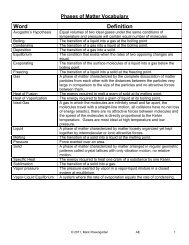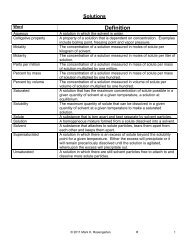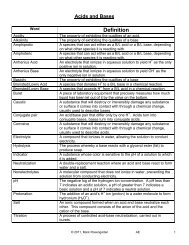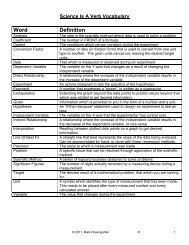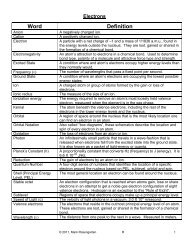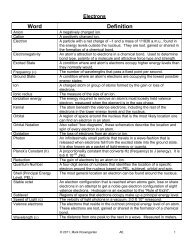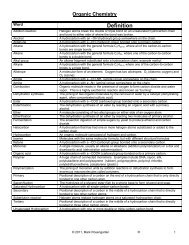Compounds - Mark Rosengarten
Compounds - Mark Rosengarten
Compounds - Mark Rosengarten
You also want an ePaper? Increase the reach of your titles
YUMPU automatically turns print PDFs into web optimized ePapers that Google loves.
3) Formula Mass Homework<br />
A) Determine the number of moles of each element present in one mole of each of the following compounds:<br />
Formula Number of: Number of: Number of:<br />
NaCl Na: Cl:<br />
CaBr 2 Ca: Br:<br />
K 2 SO 4 K: S: O:<br />
Fe 2 (CO 3 ) 3 Fe: C: O:<br />
SO 3 S: O:<br />
CH 3 COOH C: H: O:<br />
B) Determine the total number of moles of atoms in the following formulas:<br />
Formula<br />
Total Number of<br />
Moles of Atoms<br />
Formula<br />
Total Number of<br />
Moles of Atoms<br />
Formula<br />
Total Number of<br />
Moles of Atoms<br />
NaCl<br />
2 NaNO 3 4 (NH 3 ) 2 SO 4<br />
Pb 3 (PO 4 ) 2 3 K 2 Cr 2 O 7<br />
MgSO 4<br />
C) Identify each of the following as an empirical or molecular formula. If a formula is molecular, write its<br />
empirical formula.<br />
Formula<br />
Empirical or<br />
Molecular?<br />
Simplify if<br />
Molecular<br />
Formula<br />
NaCl N 2 O 4<br />
Empirical or<br />
Molecular?<br />
Simplify if<br />
Molecular<br />
C 2 H 6 Ra(CN) 2<br />
Ba(NO 3 ) 2 C 6 H 12 O 6<br />
D) Identify each statement as having been determined from quantitative or qualitative analysis.<br />
1) The compound consists of carbon, hydrogen, and chlorine.<br />
2) In a molecule of this compound, there are 6 atoms of carbon, four atoms of hydrogen, and two atoms of chlorine.<br />
© 2011, <strong>Mark</strong> <strong>Rosengarten</strong> AE 30



